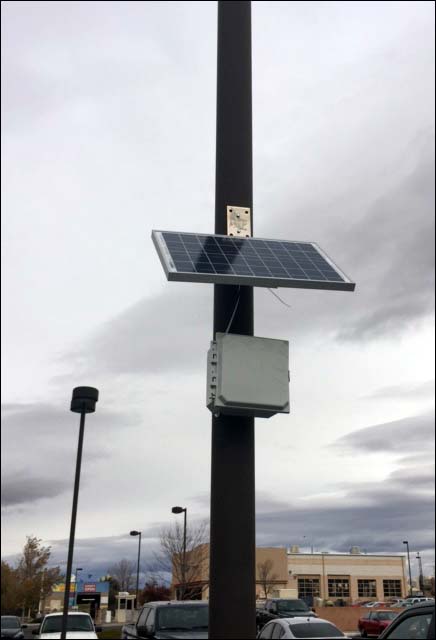When customers visit automotive dealerships, they usually already know which vehicle they’re interested in and want to see that car or truck in person, fast. The worst thing for a dealership is to have a potential customer leave because that vehicle can’t be found right away. New Mexico-based used and new car dealership Don Chalmers Ford is using a Bluetooth Low Energy (BLE)-beacon based solution provided by Minneapolis vehicle management solution company Mobile Dealer Data (MDD) ensures that customers are served more effectively since they know exactly where each vehicle is located. Having the system in place, says Brad Poole, Don Chalmers’ used car director, makes both sales representatives and customers happy, which leads to more sales.
Don Chalmers Ford has three lots: one eight-acre area at its central Rio Rancho location and two satellite sites, located a mile and seven miles from that main facility, respectively. With hundreds of vehicles at the three locations, all of which must be reconditioned prior to sale, tracking each car’s location is a monumental task. But it’s also critical, Poole says, since most buyers have visited the company’s website, have selected particular cars that interest them and arrive ready for a test drive. What they don’t want, he adds, is to wait while sales reps search for cars or trucks.
About 150 of Don Chalmers’ cars are used—which, based on internal and industry-wide requirement standards, must be sold within approximately 60 days. So the company not only wants to serve customers onsite quickly, but also to ensure that no vehicles sit for too long on the lot without being noticed.
Traditionally, the dealership applied bar codes on every vehicle it acquired, and staff members went through all three locations and scanned each bar code daily. When that became too time-consuming, Poole says, the company scaled back to scanning inventory three times a week, but that meant the count data could be several days old at any given time. Since used cars undergo washing and reconditioning processes before being sold, they often could be moved without other employees knowing about it.
“We heard about Mobile Dealer Data two years ago,” Poole says, and the company began conducting some pilots last year. The vehicle-management system has since been permanently deployed.
MobileDealerData was launched in 2012 to provide vehicle-management solutions for dealerships. Colin McElhatton, the company’s founder and CEO, has a background in automotive sales. A dealership’s inventory can be difficult to track, he explains—after all, they are all on wheels. So MDD developed a beacon-based RTLS solution. Tracking devices in each car transmit data to a dedicated reader that identifies location via triangulation. The solution is lower in cost than an active RFID solution, he says, since beacons cost considerably less than active RFID tags. The company provides the beacons, the receivers and cloud-based software for a monthly or annual fee that varies according to the number of tracking devices and receivers being used.
“Our secret sauce is the software,” McElhatton says. The software can provide analytics such as how long a particular vehicle has remained at one location (indicating it may not have been test-driven), as well as what vehicles are being moved frequently. The system tracks when a car leaves the yard and returns, so that it can also provide such analytics as how long the test drive lasted and how a test drive’s length might correlate with a sale.
The MDD system can also provide alerts to management or other personnel. For instance, it can send a text message to car-wash employees that a vehicle’s reconditioning has been completed and the car is ready to be washed, though Don Chalmers is not presently using this feature.
Altogether, the Don Chalmers dealership installed receivers at the three sites. MDD declines to reveal specifically how many were installed. With that deployment, the system can approximate a tagged vehicle’s location to within 10 to 15 feet.
When a vehicle arrives at the dealership lot, a tracking device is attached to its passenger side visor. The device’s unique ID number is linked to the vehicle’s ID in the software. When the car is parked, the software approximates the location and provides that information as an icon on a Google Maps display of the facility. The system covers the entire dealership property, including the service, reconditioning and washing areas.
With the technology in place, Poole reports, Don Chalmers is able to eliminate the inventory counts it previously performed manually, and workers can access data regarding each used vehicle’s location by signing into the software on a desktop computer or using a smartphone or tablet. “We know, every second, where the cars are,” he states, and that data is available to management, technicians and salespeople. The dealership also provides software access to vendors that provide services on its site, such as chip-and-scratch repair companies.
“We could equate some additional [car] sales to the system,” Poole says, since sales reps can quickly locate a vehicle for a customer before they might otherwise move on to another dealership.
The next phase, Poole says, is to track the movements of vehicles through the service, which is slated to go live this month. In that case, the company can apply a beacon to a car brought in for service, and then track that vehicle’s movement through the service process, so that it can quickly update a customer about the car’s status and when it will be ready for pickup. In the future, Poole adds, the company may also tag its new cars with beacons, though it has no immediate plans to do so, since new vehicles do not move around the yard as much as used models (the latter requires refurbishment prior to sales).




